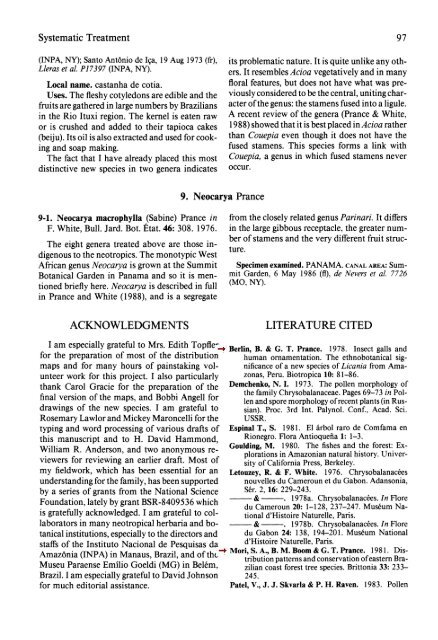flora neotropica - CNCFlora
flora neotropica - CNCFlora
flora neotropica - CNCFlora
Create successful ePaper yourself
Turn your PDF publications into a flip-book with our unique Google optimized e-Paper software.
Systematic Treatment 97<br />
(INPA, NY); Santo Ant6nio de Iga, 19 Aug 1973 (fr),<br />
Lleras et al. P17397 (INPA, NY).<br />
Local name. castanha de cotia.<br />
Uses. The fleshy cotyledons are edible and the<br />
fruits are gathered in large numbers by Brazilians<br />
in the Rio Ituxi region. The kernel is eaten raw<br />
or is crushed and added to their tapioca cakes<br />
(beiju). Its oil is also extracted and used for cooking<br />
and soap making.<br />
The fact that I have already placed this most<br />
distinctive new species in two genera indicates<br />
9-1. Neocarya macrophylla (Sabine) Prance in<br />
F. White, Bull. Jard. Bot. Etat. 46: 308. 1976.<br />
The eight genera treated above are those in-<br />
digenous to the neotropics. The monotypic West<br />
African genus Neocarya is grown at the Summit<br />
Botanical Garden in Panama and so it is men-<br />
tioned briefly here. Neocarya is described in full<br />
in Prance and White (1988), and is a segregate<br />
ACKNOWLEDGMENTS<br />
its problematic nature. It is quite unlike any others.<br />
It resembles Acioa vegetatively and in many<br />
<strong>flora</strong>l features, but does not have what was previously<br />
considered to be the central, uniting character<br />
of the genus: the stamens fused into a ligule.<br />
A recent review of the genera (Prance & White,<br />
1988) showed that it is best placed inAcioa rather<br />
than Couepia even though it does not have the<br />
fused stamens. This species forms a link with<br />
Couepia, a genus in which fused stamens never<br />
occur.<br />
9. Neocarya Prance<br />
I am especially grateful to Mrs. Edith Topfler<br />
for the preparation of most of the distribution<br />
maps and for many hours of painstaking vol-<br />
unteer work for this project. I also particularly<br />
thank Carol Gracie for the preparation of the<br />
final version of the maps, and Bobbi Angell for<br />
drawings of the new species. I am grateful to<br />
Rosemary Lawlor and Mickey Maroncelli for the<br />
typing and word processing of various drafts of<br />
this manuscript and to H. David Hammond,<br />
William R. Anderson, and two anonymous re-<br />
viewers for reviewing an earlier draft. Most of<br />
from the closely related genus Parinari. It differs<br />
in the large gibbous receptacle, the greater num-<br />
ber of stamens and the very different fruit struc-<br />
ture.<br />
Specimen examined. PANAMA. CANAL AREA: Sum-<br />
mit Garden, 6 May 1986 (fl), de Nevers et al. 7726<br />
(MO, NY).<br />
LITERATURE CITED<br />
Berlin, B. & G. T. Prance. 1978. Insect galls and<br />
human ornamentation. The ethnobotanical significance<br />
of a new species of Licania from Amazonas,<br />
Peru. Biotropica 10: 81-86.<br />
Demchenko, N. I. 1973. The pollen morphology of<br />
the family Chrysobalanaceae. Pages 69-73 in Pollen<br />
and spore morphology of recent plants (in Russian).<br />
Proc. 3rd Int. Palynol. Conf., Acad. Sci.<br />
USSR.<br />
Espinal T., S. 1981. El frbol raro de Comfama en<br />
Rionegro. Flora Antioquenia 1: 1-3.<br />
Goulding, M. 1980. The fishes and the forest: Explorations<br />
in Amazonian natural history. University<br />
of California Press, Berkeley.<br />
my fieldwork, which has been essential for an Letouzey, R. & F. White. 1976. Chrysobalanacees<br />
understanding for the family, has been supported nouvelles du Cameroun et du Gabon. Adansonia,<br />
by a series of grants from the National Science Ser. 2, 16: 229-243.<br />
--<br />
Foundation, lately by grant BSR-8409536 which<br />
& . 1978a. Chrysobalanacees. In Flore<br />
du Cameroun 20: 1-128, 237-247. Museum Nais<br />
gratefully acknowledged. I am grateful to col- tional d'Histoire Naturelle, Paris.<br />
laborators in many <strong>neotropica</strong>l herbaria and bo- & . 1978b. Chrysobalanacees. In Flore<br />
tanical institutions, especially to the directors and du Gabon 24: 138, 194-201. Museum National<br />
staffs of the Instituto Nacional de Pesquisas da d'Histoire Naturelle, Paris.<br />
Amaz6nia (INPA) in Manaus, Brazil, and of the Mori, S. A., B. M. Boom & G. T. Prance. 1981. Distribution<br />
patterns and conservation of eastern Bra-<br />
Museu Paraense Emilio Goeldi (MG) in Belem, zilian coast forest tree species. Brittonia 33: 233-<br />
Brazil. I am especially grateful to David Johnson 245.<br />
for much editorial assistance.<br />
Patel, V., J. J. Skvarla & P. H. Raven. 1983. Pollen

















